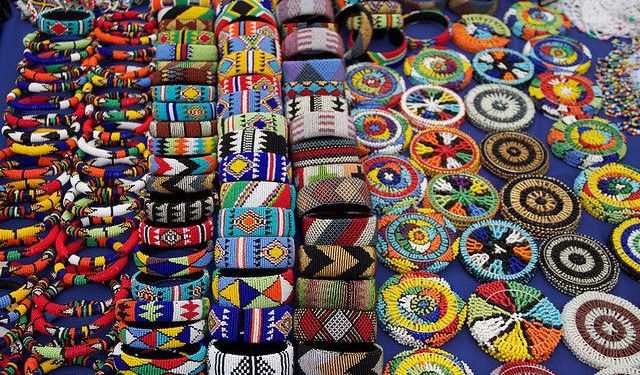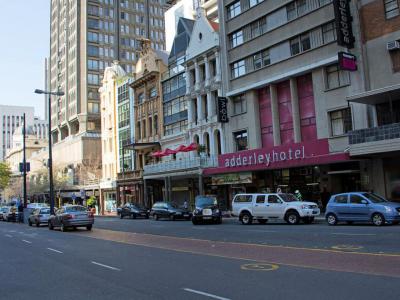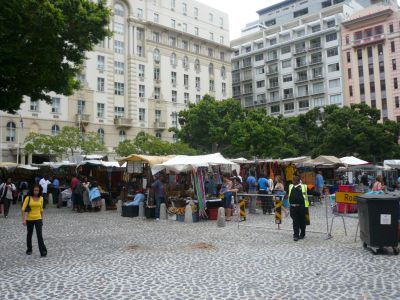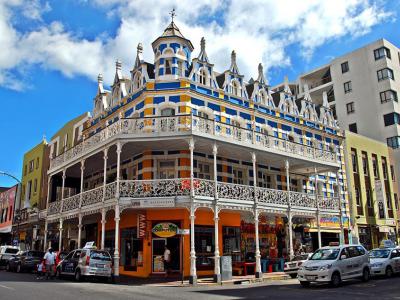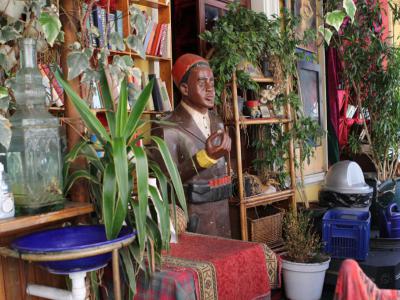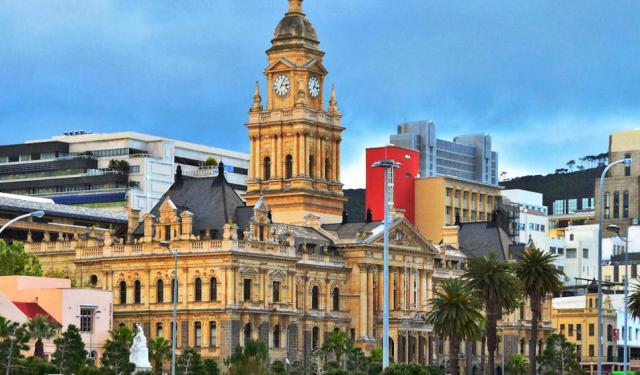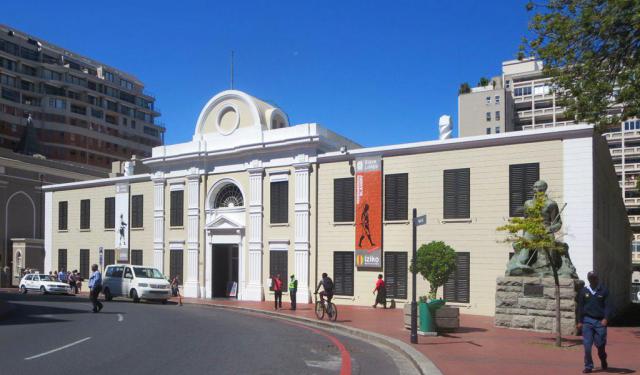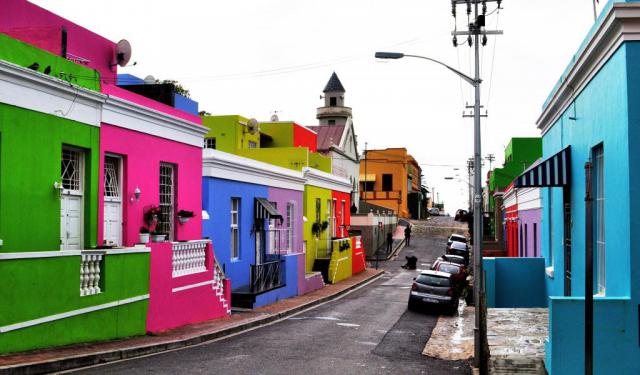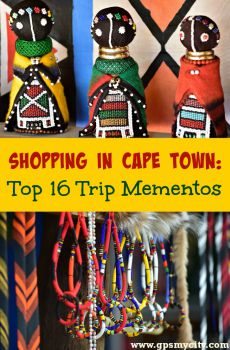Cape Town Shopping Tour (Self Guided), Cape Town
Cape Town is grand with quality shopping. The available options here, such as South Africa's top flea market where you can find a wealth of merchandise, from tribal costumes to precious jewelry, offer a colorful experience for both locals and tourists.
Among the standout locations in Cape Town that shoppers particularly love to explore is Adderley Street. This bustling thoroughfare is known for its variety of upmarket stores and boutiques that sell everything, from clothing and accessories to electronics and souvenirs. The street is also home to the historic Saint George's Mall, a pedestrian area that hosts a popular weekly market where you can discover local crafts and delicious street food.
Greenmarket Square, once the heart of Cape Town's business district, is another must-visit destination. Initially a slave market and then a cattle market, this historic square is surrounded by colorful buildings and features an open-air market that offers a wide array of handmade crafts, African art, and unique curios. It's an excellent place to pick up souvenirs or one-of-a-kind gifts.
Long Street is a lively and eclectic stretch filled with shops, cafes, and restaurants. It is known for its bohemian atmosphere and is a great place to explore if you're looking for vintage clothing, antiques, or quirky collectibles. You can also find contemporary fashion boutiques and art galleries along this bustling lane.
For those interested in African art and culture, the Pan African Market is a true gem. Located just off Long Street, this market features a curated selection of African crafts, jewelry, clothing, and artwork. It's a fantastic place to appreciate the rich cultural heritage of the continent and bring home some authentic treasures from over a dozen African countries.
As you can see, Cape Town's shopping scene is quite diverse, fit to satisfy in equal measure a fashion enthusiast, an art lover, or those looking for the perfect souvenir. Start your shopping spree now with the help of our self-guided tour and experience the vibrant culture of this beautiful city!
Among the standout locations in Cape Town that shoppers particularly love to explore is Adderley Street. This bustling thoroughfare is known for its variety of upmarket stores and boutiques that sell everything, from clothing and accessories to electronics and souvenirs. The street is also home to the historic Saint George's Mall, a pedestrian area that hosts a popular weekly market where you can discover local crafts and delicious street food.
Greenmarket Square, once the heart of Cape Town's business district, is another must-visit destination. Initially a slave market and then a cattle market, this historic square is surrounded by colorful buildings and features an open-air market that offers a wide array of handmade crafts, African art, and unique curios. It's an excellent place to pick up souvenirs or one-of-a-kind gifts.
Long Street is a lively and eclectic stretch filled with shops, cafes, and restaurants. It is known for its bohemian atmosphere and is a great place to explore if you're looking for vintage clothing, antiques, or quirky collectibles. You can also find contemporary fashion boutiques and art galleries along this bustling lane.
For those interested in African art and culture, the Pan African Market is a true gem. Located just off Long Street, this market features a curated selection of African crafts, jewelry, clothing, and artwork. It's a fantastic place to appreciate the rich cultural heritage of the continent and bring home some authentic treasures from over a dozen African countries.
As you can see, Cape Town's shopping scene is quite diverse, fit to satisfy in equal measure a fashion enthusiast, an art lover, or those looking for the perfect souvenir. Start your shopping spree now with the help of our self-guided tour and experience the vibrant culture of this beautiful city!
How it works: Download the app "GPSmyCity: Walks in 1K+ Cities" from Apple App Store or Google Play Store to your mobile phone or tablet. The app turns your mobile device into a personal tour guide and its built-in GPS navigation functions guide you from one tour stop to next. The app works offline, so no data plan is needed when traveling abroad.
Cape Town Shopping Tour Map
Guide Name: Cape Town Shopping Tour
Guide Location: South Africa » Cape Town (See other walking tours in Cape Town)
Guide Type: Self-guided Walking Tour (Sightseeing)
# of Attractions: 4
Tour Duration: 1 Hour(s)
Travel Distance: 0.4 Km or 0.2 Miles
Author: DanaOffice
Sight(s) Featured in This Guide:
Guide Location: South Africa » Cape Town (See other walking tours in Cape Town)
Guide Type: Self-guided Walking Tour (Sightseeing)
# of Attractions: 4
Tour Duration: 1 Hour(s)
Travel Distance: 0.4 Km or 0.2 Miles
Author: DanaOffice
Sight(s) Featured in This Guide:
- Adderley Street
- Greenmarket Square
- Long Street
- Pan African Market
1) Adderley Street
If you want to do some up market shopping, you should go to Adderley Street, which is the main street in Cape Town’s downtown district.
The street runs from Heerengracht to the entrance of Company Gardens, after which it becomes Government Avenue. It was named after the British Member of Parliament, Charles Bowyer Adderley, who fought against the British Government’s plans to turn the Cape are into a penal colony like Australia.
The street is full of shops, restaurants and offices. At night markets flourish and during the day a permanent market in the square in front of Central Station sells leather goods and curios. You will also find the famous Flower Market where freshly cut flowers have been sold on this spot for over 100 years.
Along the street there is the entrance to the Golden Acre, which is the oldest shopping center in South Africa. Another building of note is the Groote Kerk on Church Square. At the end of the street you will discover the Slave Lodge Museum.
In front of the museum’s entrance is a statue of Jan Smuts, who was a member of the British War Cabinet and who helped create the Royal Air Force. From 1919 to 1924 and from 1939 to 1948 he was the Prime Minister of the Union of South Africa.
The street runs from Heerengracht to the entrance of Company Gardens, after which it becomes Government Avenue. It was named after the British Member of Parliament, Charles Bowyer Adderley, who fought against the British Government’s plans to turn the Cape are into a penal colony like Australia.
The street is full of shops, restaurants and offices. At night markets flourish and during the day a permanent market in the square in front of Central Station sells leather goods and curios. You will also find the famous Flower Market where freshly cut flowers have been sold on this spot for over 100 years.
Along the street there is the entrance to the Golden Acre, which is the oldest shopping center in South Africa. Another building of note is the Groote Kerk on Church Square. At the end of the street you will discover the Slave Lodge Museum.
In front of the museum’s entrance is a statue of Jan Smuts, who was a member of the British War Cabinet and who helped create the Royal Air Force. From 1919 to 1924 and from 1939 to 1948 he was the Prime Minister of the Union of South Africa.
2) Greenmarket Square (must see)
Greenmarket Square, nestled in the heart of Cape Town's Central Business District, is a vibrant and historical marketplace that has evolved through various incarnations over the years. From its early days as a slave market to serving as a fruit and vegetable market, and even functioning as a parking lot, today it stands as a bustling flea market cherished by both locals and tourists alike.
The square offers a unique shopping experience, with its ancient cobblestones adding to the charm and providing a stark contrast to the dynamic, cosmopolitan vibe of Cape Town. The market is renowned for its wide array of informal traders who showcase a diverse range of merchandise that reflects the rich tapestry of African traditions. Shoppers can find an assortment of goods such as batiks, beadwork, sculptures, glassware, jewelry, clothing, footwear, music CDs, sunglasses, and paintings, all offered at reasonable prices.
One of the defining features of Greenmarket Square is the blend of cross-continental merchandise, which includes items from various African cultures like the Masai, Xhosa, Zulu, and the Bade tribe from Senegal. This melting pot of cultures not only offers a glimpse into the continent's diverse heritage but also allows for a shopping experience that is both adventurous and educational.
The square is not just about shopping; it's also a place where visitors can engage with the friendly, vibrant vendors who embody the diverse cultures of Cape Town. The atmosphere is further enlivened by entertainers such as buskers, drummers, jugglers, and mime artists, who add to the lively ambiance and make shopping at Greenmarket Square an unforgettable experience.
Adding to the square's appeal are the surrounding restaurants and cafés, where visitors can savor delicious local dishes and drinks. The location of Greenmarket Square is also a significant draw, as it is situated within walking distance from several key historical and cultural landmarks, including the Company Gardens, Houses of Parliament, South African Museum, Pan African Market, Castle of Good Hope, and the Old Town House, which showcases early Cape Dutch architecture and houses an important collection of Dutch and Flemish Masters' artworks.
Why You Should Visit:
Not for people looking for peace – it's a fun place to sit outside under the sun with a drink/snack and watch the activity. It's also a good place to find your souvenirs.
Tip:
As with most markets, prices vary wildly so always bargain the price. Take cash and be prepared to haggle to get a good deal.
Don't forget to visit the small, pedestrian-only streets around the Greenmarket, but be cautious/aware of your surroundings after dark.
The square offers a unique shopping experience, with its ancient cobblestones adding to the charm and providing a stark contrast to the dynamic, cosmopolitan vibe of Cape Town. The market is renowned for its wide array of informal traders who showcase a diverse range of merchandise that reflects the rich tapestry of African traditions. Shoppers can find an assortment of goods such as batiks, beadwork, sculptures, glassware, jewelry, clothing, footwear, music CDs, sunglasses, and paintings, all offered at reasonable prices.
One of the defining features of Greenmarket Square is the blend of cross-continental merchandise, which includes items from various African cultures like the Masai, Xhosa, Zulu, and the Bade tribe from Senegal. This melting pot of cultures not only offers a glimpse into the continent's diverse heritage but also allows for a shopping experience that is both adventurous and educational.
The square is not just about shopping; it's also a place where visitors can engage with the friendly, vibrant vendors who embody the diverse cultures of Cape Town. The atmosphere is further enlivened by entertainers such as buskers, drummers, jugglers, and mime artists, who add to the lively ambiance and make shopping at Greenmarket Square an unforgettable experience.
Adding to the square's appeal are the surrounding restaurants and cafés, where visitors can savor delicious local dishes and drinks. The location of Greenmarket Square is also a significant draw, as it is situated within walking distance from several key historical and cultural landmarks, including the Company Gardens, Houses of Parliament, South African Museum, Pan African Market, Castle of Good Hope, and the Old Town House, which showcases early Cape Dutch architecture and houses an important collection of Dutch and Flemish Masters' artworks.
Why You Should Visit:
Not for people looking for peace – it's a fun place to sit outside under the sun with a drink/snack and watch the activity. It's also a good place to find your souvenirs.
Tip:
As with most markets, prices vary wildly so always bargain the price. Take cash and be prepared to haggle to get a good deal.
Don't forget to visit the small, pedestrian-only streets around the Greenmarket, but be cautious/aware of your surroundings after dark.
3) Long Street (must see)
If you want to get a taste of African cuisine and Cape Town’s nightlife, Long Street in the City Bowl District is the place to go.
During the 1960s and early 70s this was the place to be if you had a bohemian outlook and anti-apartheid. This area was the San Francisco of South Africa. Little has changed over the years.
This is one of the oldest streets in Cape Town and it is still surrounded by beautiful Victorian buildings that have balconies enclosed by ornately wrought iron grills. During the day bookshops, stands selling souvenirs and antique shops are happy to welcome visitors, but Long Street comes alive as soon as the sun sets.
If you have been longing to taste an ostrich steak or prawns from Mozambique, you can get both here in one of the many restaurants that serve African food. If you want to eat curry, don’t worry! On Long Street, you will find the spiciest Indian food that you have ever tasted.
If you want to dine and dance, several bar/restaurants offer a tasty meal and then put on a variety of music from local ethnic to heavy metal. If you want a calm night out, some bars feature poetry reading sessions with alcohol-free cocktails afterward.
During the 1960s and early 70s this was the place to be if you had a bohemian outlook and anti-apartheid. This area was the San Francisco of South Africa. Little has changed over the years.
This is one of the oldest streets in Cape Town and it is still surrounded by beautiful Victorian buildings that have balconies enclosed by ornately wrought iron grills. During the day bookshops, stands selling souvenirs and antique shops are happy to welcome visitors, but Long Street comes alive as soon as the sun sets.
If you have been longing to taste an ostrich steak or prawns from Mozambique, you can get both here in one of the many restaurants that serve African food. If you want to eat curry, don’t worry! On Long Street, you will find the spiciest Indian food that you have ever tasted.
If you want to dine and dance, several bar/restaurants offer a tasty meal and then put on a variety of music from local ethnic to heavy metal. If you want a calm night out, some bars feature poetry reading sessions with alcohol-free cocktails afterward.
4) Pan African Market
One of the best places to visit in Cape Town is undoubtedly the Pan African Market which is lodged in a superb building on Long Street.
In 1997 five traders took over an abandoned building on Long Street and set up a market on the first floor. At first the town council decided to chase them out, but seeing that locals and tourists alike flocked to the area, they granted a long term lease on the building and renovated it so that the market could grow.
Today, the market holds over 35 stalls with permanent shops on the second and third floors. These shops and stalls represent goods from over 14 African countries including Kenya, Senegal, Mozambique and Cameroon.
This fabulous market offers a wide range of arts and crafts and bargain is the name of the day! Don’t look at the price tags – if you want to buy a tribal mask or a piece of authentic bead jewelry – the more you haggle with the stall holder, the happier he’ll be and the price will be lowered!
There are tailors who will run up a tribal costume in an hour, so while you are waiting you will have the time to browse through stands selling tribal drums or visit the numerous “witch doctors” where you can buy natural remedies for everything from in-growing toenails to hair loss!
In 1997 five traders took over an abandoned building on Long Street and set up a market on the first floor. At first the town council decided to chase them out, but seeing that locals and tourists alike flocked to the area, they granted a long term lease on the building and renovated it so that the market could grow.
Today, the market holds over 35 stalls with permanent shops on the second and third floors. These shops and stalls represent goods from over 14 African countries including Kenya, Senegal, Mozambique and Cameroon.
This fabulous market offers a wide range of arts and crafts and bargain is the name of the day! Don’t look at the price tags – if you want to buy a tribal mask or a piece of authentic bead jewelry – the more you haggle with the stall holder, the happier he’ll be and the price will be lowered!
There are tailors who will run up a tribal costume in an hour, so while you are waiting you will have the time to browse through stands selling tribal drums or visit the numerous “witch doctors” where you can buy natural remedies for everything from in-growing toenails to hair loss!
Walking Tours in Cape Town, South Africa
Create Your Own Walk in Cape Town
Creating your own self-guided walk in Cape Town is easy and fun. Choose the city attractions that you want to see and a walk route map will be created just for you. You can even set your hotel as the start point of the walk.
Cape Town Introduction Walking Tour
Portuguese explorer Bartolomeu Dias first mentioned the Cape of Storms in 1488, but it was soon renamed the Cape of Good Hope with an optimistic eye towards the trade routes it offered between Europe and the East.
In 1652, the Dutch East India Company settled a way-station here for ships traveling that route. Cape Town's natural harbor and strategic position made it the perfect location.... view more
Tour Duration: 1 Hour(s)
Travel Distance: 2.1 Km or 1.3 Miles
In 1652, the Dutch East India Company settled a way-station here for ships traveling that route. Cape Town's natural harbor and strategic position made it the perfect location.... view more
Tour Duration: 1 Hour(s)
Travel Distance: 2.1 Km or 1.3 Miles
Historical Houses Walking Tour
When Jan van Riebeeck arrived in Cape Town in 1652, his mission was to establish here a supply station for the ships of the Dutch East India Company sailing to East Africa, India, and the Far East. The oldest buildings in today's Cape Town, dating from the second half of the 17th century, are the remnants of that era.
Garden House, originally a shabby tool shed owned by the Dutch East... view more
Tour Duration: 1 Hour(s)
Travel Distance: 2.8 Km or 1.7 Miles
Garden House, originally a shabby tool shed owned by the Dutch East... view more
Tour Duration: 1 Hour(s)
Travel Distance: 2.8 Km or 1.7 Miles
Bo-Kaap Quarter Walking Tour
Bo-Kaap is Afrikaans for "above the Cape." The Bo-Kaap District is above Cape Town's city center, on the slopes of Signal Hill. It is the historical center of Cape Malay culture. In the 1760s, Jan de Waal bought land here and built houses he rented to his slaves.
Slaves came from Malaysia, Indonesia, and other parts of Africa. Many of these slaves were Muslim, and this area... view more
Tour Duration: 1 Hour(s)
Travel Distance: 1.0 Km or 0.6 Miles
Slaves came from Malaysia, Indonesia, and other parts of Africa. Many of these slaves were Muslim, and this area... view more
Tour Duration: 1 Hour(s)
Travel Distance: 1.0 Km or 0.6 Miles
Useful Travel Guides for Planning Your Trip
16 Distinctively South African Things to Buy in Cape Town
The many hopes pinned on this place (Cape of Good Hope) by passing-by sailors over the centuries must have done a good job for Cape Town, seeing it become a colorful cultural hub and prominent metropolis (3rd largest) in South Africa. Overlooking the meeting point of the two oceans (Indian and...
The Most Popular Cities
/ view all
